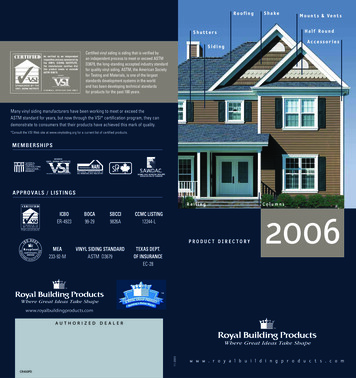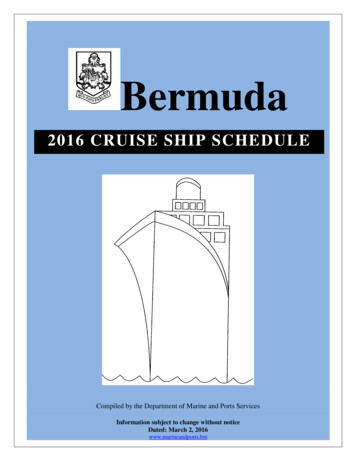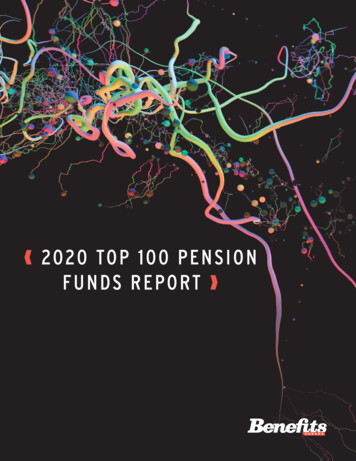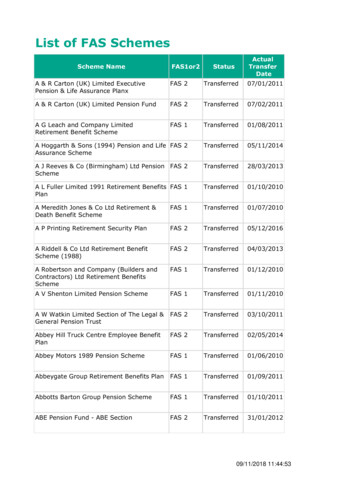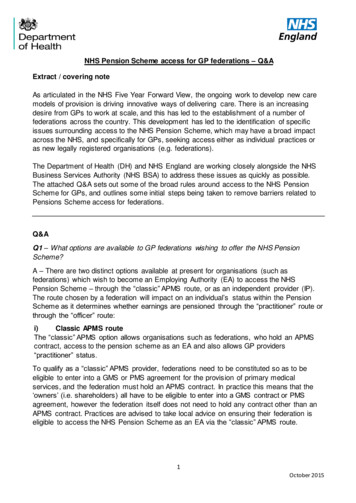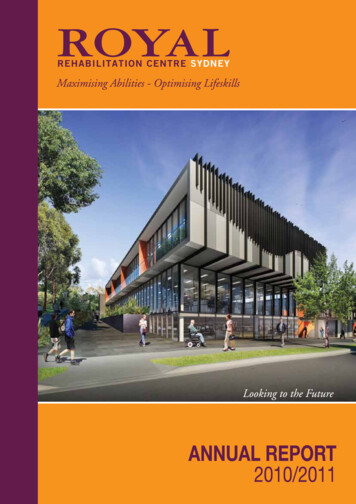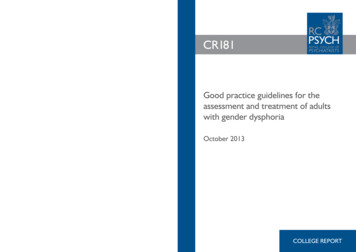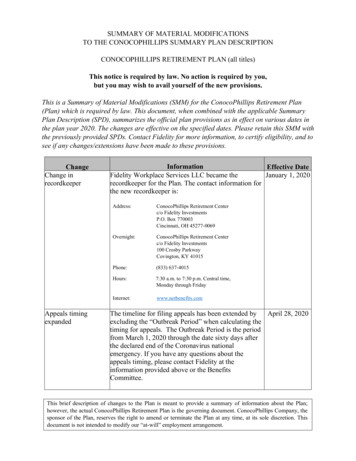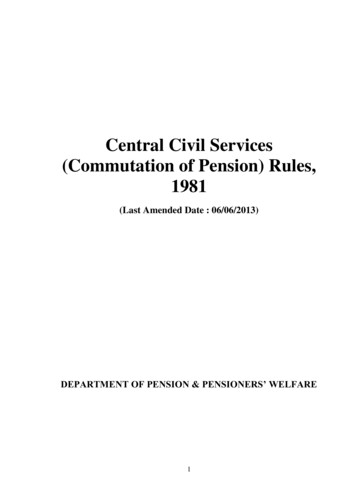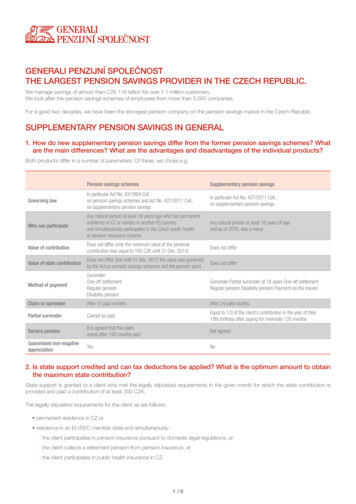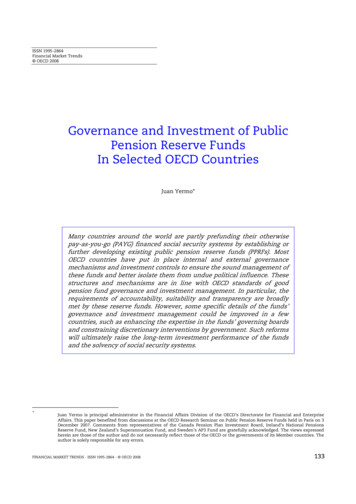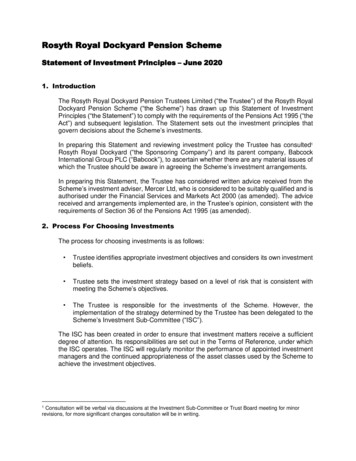
Transcription
Rosyth Royal Dockyard Pension SchemeStatement of Investment Principles – June 20201. IntroductionThe Rosyth Royal Dockyard Pension Trustees Limited (“the Trustee”) of the Rosyth RoyalDockyard Pension Scheme (“the Scheme”) has drawn up this Statement of InvestmentPrinciples (“the Statement”) to comply with the requirements of the Pensions Act 1995 (“theAct”) and subsequent legislation. The Statement sets out the investment principles thatgovern decisions about the Scheme’s investments.In preparing this Statement and reviewing investment policy the Trustee has consulted1Rosyth Royal Dockyard (“the Sponsoring Company”) and its parent company, BabcockInternational Group PLC (“Babcock”), to ascertain whether there are any material issues ofwhich the Trustee should be aware in agreeing the Scheme’s investment arrangements.In preparing this Statement, the Trustee has considered written advice received from theScheme’s investment adviser, Mercer Ltd, who is considered to be suitably qualified and isauthorised under the Financial Services and Markets Act 2000 (as amended). The advicereceived and arrangements implemented are, in the Trustee’s opinion, consistent with therequirements of Section 36 of the Pensions Act 1995 (as amended).2. Process For Choosing InvestmentsThe process for choosing investments is as follows: Trustee identifies appropriate investment objectives and considers its own investmentbeliefs. Trustee sets the investment strategy based on a level of risk that is consistent withmeeting the Scheme’s objectives. The Trustee is responsible for the investments of the Scheme. However, theimplementation of the strategy determined by the Trustee has been delegated to theScheme’s Investment Sub-Committee (“ISC”).The ISC has been created in order to ensure that investment matters receive a sufficientdegree of attention. Its responsibilities are set out in the Terms of Reference, under whichthe ISC operates. The ISC will regularly monitor the performance of appointed investmentmanagers and the continued appropriateness of the asset classes used by the Scheme toachieve the investment objectives.1Consultation will be verbal via discussions at the Investment Sub-Committee or Trust Board meeting for minorrevisions, for more significant changes consultation will be in writing.
Page 2 of 113. Investment ObjectivesThe Trustee’s objective is to invest the Scheme’s assets in the best interests of themembers and beneficiaries. The Trustee has agreed a number of objectives to help guideits strategic management of the assets and control the various risks to which the Schemeis exposed. The Trustee’s primary objectives are as follows: To ensure that the Scheme’s benefit obligations can be met. That, overall, there is a high level of security of benefits.While security is paramount, the Trustee recognises that a “least risk” approach toinvestment strategy would substantially increase the cost of the Scheme (possibly tounacceptable levels). The Trustee has thus decided to pursue a strategy which takes onsome investment risk in a controlled fashion.This leads to two further specific objectives: To aim for a long term return which, if achieved, should improve and then maintain theScheme’s funding level. To adopt a strategy which aims to limit the level of investment risk, and the resultingfunding level, deficit and contribution volatilities, to an acceptable level.This has led to the adoption of a Scheme-specific investment strategy, which isimplemented on a day to day basis by the investment managers. The Trustee has alsodecided to adopt a long-term funding which would reduce, in the long term, dependence onthe Sponsoring Company. The Trustee has agreed to move towards this target (which ismeasured on a gilts related basis) through a long-term de-risking strategy.The Trustee will continue to monitor the appropriateness of the strategy and the pathtowards the long-term funding target, and revisit this approach should it be necessary to doso. The Trustee has considered the level of risk inherent in the chosen investment strategy,based on advice provided by Mercer, its investment advisor, and is comfortable with thislevel of risk.
Page 3 of 114. Risk Management and MeasurementThe risks affecting the Scheme can be broadly split out into those that could directly affectthe funding position of the Scheme and investment risks that could specifically affect theScheme’s assets. The Trustee’s policy on risk management is as follows:1. Funding Level Risks The primary risk arises through a mismatch between the Scheme’s assets and itsliabilities. The Trustee recognises that increasing the potential for additional returnsthrough increasing investment risk also increases the risk of a shortfall in assetsrequired to cover the Scheme’s liabilities as well as producing short-term volatility inthe Scheme’s funding position. The Trustee has taken advice on the matter and (inlight of the objectives noted previously) considered carefully the implications ofadopting different investment strategies with different levels of risk. The Trustee recognises the risks that may arise due to the sensitivity of the value ofthe Scheme’s liabilities to changes in interest rates and inflation. The Trustee hasconsidered these risks and has decided to hedge the interest rate and inflation riskassociated with the Scheme’s liabilities up to the de-risking funding level such that thede-risking funding level is broadly unaffected by changes in interest rates and inflation. In order to manage the overall risk of the Scheme, the Trustee has established a 1year 95% Value at Risk ceiling of 96m measured on an IAS19 basis. The Trusteehas appointed an independent party to measure the risk of the Scheme relative to theceiling on a quarterly basis. Should risk increase above this level, it will be reducedback to being below the ceiling at the earliest opportunity unless otherwise agreed. The Trustee recognises the risks that may arise from changes in the value of theScheme’s liabilities due to improving life expectancy. The Trustee has consideredthese risks and in 2009 decided to enter into a longevity swap agreement covering thepensioner liabilities at that time in order to mitigate some of this risk. The Trustee has to post collateral in relation to the longevity swap and other derivativeinstruments in which the Scheme invests. The Trustee understands the collateralrequirements will change and these are reviewed regularly. The collateral requirementwill be managed within the Scheme’s Matching portfolio. The Trustee recognises that the funding level of the Scheme will be volatile and hasadopted a de-risking approach to help protect improvements in the de-risking fundingposition when they are achieved.2. Investment-Specific Risks Arrangements are in place to monitor the Scheme’s investments to check that nothinghas occurred that would bring into question the continuing suitability of the currentinvestments. To facilitate this, the Trustee meets regularly and receives regularreports from the ISC and Mercer.
Page 4 of 11 The Trustee recognises a number of additional risks and has delegated appropriatepowers to the ISC to enable the ISC to manage these risks. The use of active management gives rise to the risk that the performance achievedwithin each asset class may be lower than expected. However, the Trustee believesthat this risk is outweighed by the potential gains from successful active managementif the manager’s skills have been carefully assessed. The Trustee believes there is arole for both active and passive management. Passive management may be used forone of a number of reasons, including investment in markets deemed “efficient”, wherethe scope for active management to add value is limited. The Trustee recognises the risks that may arise from a lack of diversification ofinvestments and aims to ensure the policy in place results in an adequately diversifiedportfolio. The Trustee and ISC recognise that short and medium term investment opportunitieswill arise throughout the lifetime of the Scheme. The ISC will generally only look totake advantage of medium to long term investment opportunities, whilst shorter termdecisions regarding the investment and the selection of specific stocks are delegatedto the Scheme’s investment managers. Where the Scheme holds investments denominated in foreign currencies, there is therisk that fluctuations in foreign exchange rates may reduce the returns on theseinvestments. The Trustee hedges a proportion of currency risk. The safe custody of the Scheme’s assets is delegated to professional custodians.Northern Trust is the global custodian for the Scheme. There should be no investment in securities issued by the Sponsoring Company oraffiliated companies (other than any such securities held within a pooled fund in whichthe Scheme invests). Borrowing is only permitted to cover short term liquidity requirements and for hedgingpurposes.In addition, the Trustee is required to provide narrative disclosures on the credit andmarket risks arising from its investment arrangements in the Trustee Annual Report andAccounts. These risks are defined as follows: Credit risk: this is the risk that one party to a financial instrument will cause a financialloss for the other party by failing to discharge an obligation. Market risk: this is the risk that the fair value or future cash flows of a financialinstrument will fluctuate because of changes in market prices. Market risk comprisesthree types of risk: currency risk, interest rate risk and other price risk, each of whichis further detailed as follows:oCurrency risk: this is the risk that the fair value or future cash flows of a financialasset will fluctuate because of changes in foreign exchange rates.
Page 5 of 113.oInterest rate risk: this is the risk that the fair value or future cash flows of afinancial asset will fluctuate because of changes in market interest rates.oOther price risk: this is the risk that the fair value or future cash flows of a financialasset will fluctuate because of changes in market prices (other than those arisingfrom interest rate risk or currency risk), whether those changes are caused byfactors specific to the individual financial instrument or its issuer, or factorsaffecting all similar financial instruments traded in the market.oEnvironmental, Social and Governance (“ESG”) risk: ESG issues includingclimate change may have substantial impacts on the global economy andsubsequently investment returns. The Trustee seeks to minimise this risk bymonitoring and regularly reviewing that advisers and fund managers to theScheme (via the ISC) are suitably experienced to consider these risks in theservice they provide to the Scheme.The above risks are in relation to what the Trustee considers to be ‘financially materialconsiderations’. The Trustee believes the appropriate time horizon over which toassess these considerations will be dependent on the maturity of the Scheme andthe Trustee’s view of the employer covenant.5. Investment StrategyThe Trustee has adopted a strategy with the aim of generating sufficient investment returnsto achieve the Scheme’s investment objectives. Should there be a material change in theScheme’s circumstances, the Trustee will review whether and to what extent the investmentstrategy should be altered.The investment strategy takes account of: the maturity profile of the Scheme (in terms of the relative proportions of liabilities inrespect of pensioners and non-pensioners); the funding level on the de-risking basis; the expected strength of covenant of the principal employer; and the Scheme’s liquidity requirements (which includes collateral requirementsarising from the Scheme’s investments in LDI assets). The Trustee monitors theScheme’s liquidity and collateral requirements on a regular basis (via the ISC).
Page 6 of 11The asset allocation as at 31 December 2019 is as follows:PortfolioAsset Allocation (%)Growth30.7Low Risk and Income32.7Matching36.6Total100.0Source: Northern Trust, Investment Managers and Mercer. Figures may not sum due to roundingThe Growth Portfolio is designed to generate a long-term return of at least 3.5% p.a. abovecash after fees. By allocating assets to a range of asset classes, and through the use ofactive management, it is intended that this additional return is generated in an efficientmanner (i.e. expected returns are maximised relative to expected risk). The Trusteedelegates the design of the Growth Portfolio to the ISC.The Growth Portfolio is managed by the ISC under the following guidelines:Lower Limit(% of GrowthPortfolio)Upper Limit(% of GrowthPortfolio)Public Equities*060Growth Fixed Income**050Real Assets ***020Multi strategy funds020Other alternatives (e.g.insurance linked securities)05Asset Class******e.g. UK, Global and emerging marketsIncluding but not limited to multi-asset credit funds, emerging market debt and high yield bondse.g. real estate and commoditiesThe ranges show the possible allocation that can be made to each of the asset classes.The Trust Board recognises that market movements may cause the Scheme’s allocationsto these asset classes to drift above (or below) the upper limit (or lower limit). Rebalancingof the Scheme’s assets may take place over a number of months. Deviations outside thelimits above will be reported to the Trust Board.The ISC would request Trust Board authorisation (and consult with the Company) if anynew investment was considered ‘illiquid’ e.g. a lock up of greater than 3 years. Further, theISC would only invest in new asset classes having taken appropriate advice from the Trustboard’s investment advisors. In addition, should the ISC make an allocation to ‘Other
Page 7 of 11Alternatives’ the ISC will report this to the Trust Board. If an allocation outside the rangesset out above is desired, the ISC would request Trust Board authorisation by email inadvance.The Low Risk and Income Portfolio is designed to reduce risk and generate a long-termreturn of at least 1.5% p.a. above cash after fees. The primary aim for the portfolio is togenerate positive returns over the longer term with low volatility while generating someincome to meet benefit payments. Where applicable the avoidance of default risk is anobjective. The Trustee delegates the design of the Low Risk and Income Portfolio to theISC.The Low Risk and Income Portfolio is managed by the ISC under the following guidelines:Lower Limit (% of LowRisk and IncomePortfolio)Upper Limit (% ofLow Risk andIncome Portfolio)Investment GradeCorporate Bonds2060Absolute Return Bonds050Asset Backed Securities050High Lease to ValueProperty020Illiquid Credit*1050Other alternatives05Asset Class* e.g. High yielding income generating assets, secured finance and private debtThe ranges show the possible allocation that can be made to each of the asset classes.The Trust Board recognises that market movements may cause the Scheme’s allocationsto these asset classes to drift above (or below) the upper limit (or lower limit). Rebalancingof the Scheme’s assets may take place over a number of months. Deviations outside thelimits above will be reported to the Trust Board.The ISC would request Trust Board authorisation (and consult with the Company) if anynew investment was considered ‘illiquid’ e.g. a lock up of greater than 3 years. Further, theISC would only invest in new asset classes having taken appropriate advice from the Trustboard’s investment advisors. In addition, should the ISC make an allocation to ‘OtherAlternatives’ the ISC will report this to the Trust Board. If an allocation outside the rangesset out above is desired, the ISC would request Trust Board authorisation by email inadvance.The Matching Portfolio is a very low risk portfolio relative to the liabilities, which consists ofgilts, gilt repos, cash and swaps. Its primary aim is to hedge the liabilities, such that thehedge ratio as a proportion of de-risking liabilities is in line with the Scheme’s funding levelon a de-risking basis, i.e. to match movements in the de-risking funding level caused byinterest rate and inflation changes. The Trustee delegates the design of the MatchingPortfolio to the ISC.
Page 8 of 11In addition, the ISC can use equity futures as a short term measure to implement de-riskingor re-risking.Further details regarding the investment strategy’s implementation framework can be foundin the IPID.6.De-risking and Re-risking of AssetsThe Trustee has put in place a dynamic de-risking framework which stipulates that thelevel of risk from the Scheme’s assets should be no greater than required for the longterm funding objective (full funding on a gilts flat basis by 31 March 2037) to be achieved.The ISC will oversee the de-risking or re-risking of the Scheme. The ISC will report backto the Trustee when any de-risking or re-risking takes place.The Trustee can delegate discretion to its ISC representatives to increase or decreasethe expected return of the Scheme’s assets to within 0.2% p.a. either side of the longterm required return. The Trustee can suspend the discretion at any time.The required return is the return on assets required for the long term funding objective tobe achieved. If the expected return is ahead of the long term required return by more than0.2% p.a. the Scheme’s representatives are required to de-risk such that the expectedreturn is within /-0.2% p.a. of the required return.The technical provisions required return is a hard floor for all de-risking decisions. TheISC discretion may not reduce the expected return to below this level (even if theexpected return is above long term required return by more than 0.2% p.a.). The ISCmust also be mindful of the risk ceiling and market conditions for any decision (de-riskingand re-risking) taken.At any time the ISC may propose de-risking or re-risking to the Trustee if they deem thisto be appropriate beyond the discretion framework that has been agreed with the Trustee.Company consultation could be required if the Trustee supports the proposal.The de-risking framework will be reviewed and updated once a year by the Trustee at aminimum or more frequently if there have been any material changes to the Scheme.7. Day–to-Day Management of the AssetsThe day to day management of the assets has been delegated to a number of investmentmanagers. The ISC has taken steps to satisfy itself that the managers have the appropriateknowledge and experience for managing the Scheme’s investments and that they arecarrying out their work competently.The ISC has determined, based on expert advice, a benchmark mix of asset types andranges within which each appointed investment manager may operate.The ISC regularly reviews the continuing suitability of the Scheme’s investments, includingthe appointed managers and the balance between active and passive management, whichmay be adjusted from time to time. However, any such adjustments would be done withthe aim of ensuring the overall levels of risk and return are consistent with those beingtargeted by the Trustee.
Page 9 of 118. Additional AssetsWhilst the main Scheme assets are invested in line with the above, additional voluntarycontributions (“AVC’s”) are invested in options made available in the Babcock InternationalGroup Pension Scheme with the exception of Utmost.9. Realisation of InvestmentsThe investment managers have discretion in the timing of realisation of investments.The ISC monitors the allocation between the appointed managers and between assetclasses and will rebalance to any parameters agreed by the Trustee.10. Responsible Investment and Corporate GovernanceThe Trustee believes that environmental, social, and corporate governance (“ESG”) factorsmay have a material impact on investment risk and return outcomes, and that goodstewardship can create and preserve value for companies and markets as a whole. TheTrustee also recognises that long-term sustainability issues, particularly climate change,present risks and opportunities that increasingly may require explicit consideration. TheTrustee takes a pragmatic approach to ESG issues and considers their materiality in termsof both risk and return.The Trustee has given appointed investment managers full discretion in evaluating ESGfactors, including climate change considerations, and exercising voting rights andstewardship obligations attached to the investments, in accordance with their owncorporate governance policies and current best practice, including the UK CorporateGovernance Code and UK Stewardship Code. The Trustee encourages the Scheme’smanagers to comply with the UK Stewardship Code.The Trustee has communicated to the managers (via the ISC) clear expectations that theScheme’s investment managers consider the risks and return opportunities that may ariseby considering ESG factors within their overall investment processes.The ISC on behalf of the Trustee considers how ESG, climate change and stewardship isintegrated within investment processes in appointing new investment managers andmonitoring existing investment managers. Monitoring is undertaken on a regular basis.The ISC also considers the investment advisor’s assessment of how each of the investmentmanagers embed ESG into their investment process and how the managers’ responsibleinvestment philosophy aligns with the Trustee’s responsible investment policy. Thisincludes the investment managers’ policy on voting and engagement. The Trustee will usethis assessment in decisions around selection, retention and realisation of managerappointments.The ISC regularly reviews the decisions made by their managers, including voting history(in respect of equities) and engagement activity, and can challenge such decisions to try toensure the best long term performance over the medium to long term. In addition, the ISCcarries out regular reviews of the investment managers’ ESG policies and actively engageswith investment managers to better understand their processes.
Page 10 of 11The Trustee has not currently set any investment restrictions on the appointed investmentmanagers in relation to particular products or activities. Investment managers are awarethat their continued appointment is based on their success in delivering the mandate forwhich they have been appointed to manage. If the Trustee is dissatisfied, then they will lookto replace the manager.Member views are not taken into account in the selection, retention and realisation ofinvestments.11. Investment Manager Appointment, Engagement and MonitoringIn line with sections 2-3 of the SIP, investment managers are appointed based on theircapabilities and, therefore, their perceived likelihood of achieving the expected return andrisk characteristics required for the asset class for which they are selected.The Trustee looks to its investment advisor for their forward looking assessment of amanager’s ability to outperform over a full market cycle. This view will be based on theadvisor’s assessment of the manager’s idea generation, portfolio construction,implementation and business management, in relation to the particular investment fund thatthe Scheme invests in. The advisor’s manager research ratings assist with due diligenceand questioning managers during presentations to the ISC/Trustee and are used indecisions around selection, retention and realisation of manager appointments.As part of the ISC’s regular reporting to the Trustee, the Trustee receives investmentmanager performance reports on a quarterly basis, which present performance informationover 3 months, 1 year, 3 years and since inception. The Trustee reviews the absoluteperformance, relative performance against a suitable index used as the benchmark, andagainst the manager’s stated target performance (over the relevant time period) on a netof fees basis. The Trustee’s focus is on long term performance but will put a manager ‘onwatch’ if there are short term performance concerns.If a manager is not meeting performance objectives, or their investment objectives for themandate have changed, the Trustee will review the fund appointment to ensure it remainsappropriate and consistent with the Trustee’s wider investment objectives and may ask themanager to review their fees – either the Annual Management Charge or the performancerelated fee element.Some appointments are actively managed and the managers are incentivised throughremuneration (via performance related fees, noting that some have hurdle rate structuresin place to avoid the Trustee paying additional fees during periods of long termunderperformance) and performance targets (an appointment will be reviewed followingperiods of sustained underperformance). The Trustee will review the appropriateness ofusing actively managed funds (on an asset class basis) regularly.As the Trustee invests in some pooled investment vehicles they accept that they have noability to specify the risk profile and return targets of the manager, but appropriate mandatescan be selected to align with the overall investment strategy.The Trustee monitors portfolio turnover costs by adhering to the Cost TransparencyInitiative, under which ClearGlass will collect data on the costs of the Scheme’s investmentmanagers, and as part of regular governance reviews. The Trustee will engage with a
Page 11 of 11manager if portfolio turnover is higher than expected. This is assessed by comparingportfolio turnover as reported by the investment managers, across the same asset class,on a year-for-year basis for the same manager fund, or relative to the manager’s specifiedportfolio turnover range in the investment guidelines or prospectus (where applicable).The Trustee is a long term investor and is not looking to change the investmentarrangements on a frequent basis.For open-ended funds in which the Scheme invests, there is no set duration for the managerappointments. The Trustee will retain an investment manager unless there is a strategicchange to the overall strategy that no longer requires exposure to that asset class ormanager; or the manager appointment has been reviewed and the Trustee has decided toterminate For closed-ended funds, the Scheme is invested in a manager’s fund for thelifetime of the fund. At the time of appointment, the investment managers provided anindication of the expected investment duration of their funds and have the discretion toextend the lifetime of the fund in line with the Investment Management Agreement. In orderto maintain a strategic allocation to such asset classes, the Trustee may choose to staywith a manager in a new closed fund for that asset class or appoint a different manager.12. Review of this StatementThe Trustee will review this Statement at least annually and without delay after anysignificant change in investment policy. Any change to this Statement will only be madeafter having obtained and considered the written advice of someone who the Trusteereasonably believes to be qualified by their ability in and practical experience of financialmatters and to have the appropriate knowledge and experience of the management ofpension scheme investments. The Sponsoring Company will also be consulted regardingany change to this Statement.13. Compliance with this StatementThe Trustee monitors compliance with this Statement annually.SignedDated10 July 2020
Page 3 of 11 4. Risk Management and Measurement The risks affecting the Scheme can be broadly split out into those that could directly affect the funding position of the Scheme and investment risks that could specifically affect the Scheme's assets. The Trustee's policy on risk management is as follows: 1. Funding Level Risks
